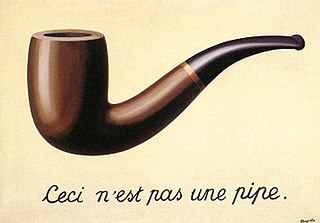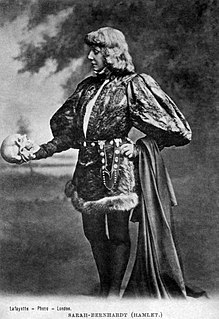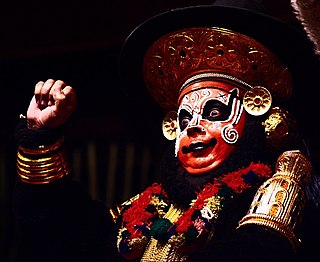
Surrealism was a cultural movement that developed in Europe in the aftermath of World War I in which artists depicted unnerving, illogical scenes and developed techniques to allow the unconscious mind to express itself. Its aim was, according to leader André Breton, to "resolve the previously contradictory conditions of dream and reality into an absolute reality, a super-reality", or surreality. It produced works of painting, writing, theatre, filmmaking, photography, and other media.

Tragedy is a genre of drama based on human suffering and, mainly, the terrible or sorrowful events that befall a main character. Traditionally, the intention of tragedy is to invoke an accompanying catharsis, or a "pain [that] awakens pleasure", for the audience. While many cultures have developed forms that provoke this paradoxical response, the term tragedy often refers to a specific tradition of drama that has played a unique and important role historically in the self-definition of Western civilization. That tradition has been multiple and discontinuous, yet the term has often been used to invoke a powerful effect of cultural identity and historical continuity—"the Greeks and the Elizabethans, in one cultural form; Hellenes and Christians, in a common activity," as Raymond Williams puts it.

Guillaume Apollinaire was a French poet, playwright, short story writer, novelist, and art critic of Polish-Belarusian descent.

In Greek mythology, Tiresias was a blind prophet of Apollo in Thebes, famous for clairvoyance and for being transformed into a woman for seven years. He was the son of the shepherd Everes and the nymph Chariclo. Tiresias participated fully in seven generations in Thebes, beginning as advisor to Cadmus himself.
The Lenaia was an annual Athenian festival with a dramatic competition. It was one of the lesser festivals of Athens and Ionia in ancient Greece. The Lenaia took place in Athens in Gamelion, roughly corresponding to January. The festival was in honour of Dionysus Lenaios. There is also evidence the festival also took place in Delphi.

Alcestis is an Athenian tragedy by the ancient Greek playwright Euripides. It was first produced at the City Dionysia festival in 438 BC. Euripides presented it as the final part of a tetralogy of unconnected plays in the competition of tragedies, for which he won second prize; this arrangement was exceptional, as the fourth part was normally a satyr play. Its ambiguous, tragicomic tone—which may be "cheerfully romantic" or "bitterly ironic"—has earned it the label of a "problem play." Alcestis is, possibly excepting the Rhesus, the oldest surviving work by Euripides, although at the time of its first performance he had been producing plays for 17 years.

Oh, What a Lovely War! is an epic musical developed by Joan Littlewood and her ensemble at the Theatre Workshop in 1963. It is a satire on World War I, and by extension on war in general. The title is derived from the "somewhat satirical" music hall song "Oh! It's a Lovely War!", which is one of the major numbers in the production.

Les Mamelles de Tirésias is an opéra bouffe by Francis Poulenc, in a prologue and two acts based on the eponymous play by Guillaume Apollinaire. The opera was written in 1945 and first performed in 1947. Apollinaire's play, written in 1903, was revised with a sombre prologue by the time it premiered during World War I in France. For the opera, Poulenc incorporated both the farcical and the serious aspects of the original play, which according to one critic displays a "high-spirited topsy-turveydom" that conceals "a deeper and sadder theme – the need to repopulate and rediscover a France ravaged by war."

The term Indian classical drama refers to the tradition of dramatic literature and performance in ancient India. The origin of dramatic performance in the Indian subcontinent can be traced back to as early as 200 BCE. Its drama is regarded as the highest achievement of Sanskrit literature. Buddhist philosopher Asvaghosa, who composed Buddhacarita, is considered to have been the first Sanskrit dramatist.

Nineteenth-century theatre describes a wide range of movements in the theatrical culture of Europe and the United States in the 19th century. In the West, they include Romanticism, melodrama, the well-made plays of Scribe and Sardou, the farces of Feydeau, the problem plays of Naturalism and Realism, Wagner's operatic Gesamtkunstwerk, Gilbert and Sullivan's plays and operas, Wilde's drawing-room comedies, Symbolism, and proto-Expressionism in the late works of August Strindberg and Henrik Ibsen.

Medieval theatre encompasses theatrical performance in the period between the fall of the Western Roman Empire in the 5th century and the beginning of the Renaissance in approximately the 15th century. The category of "medieval theatre" is vast, covering dramatic performance in Europe over a thousand-year period. A broad spectrum of genres needs to be considered, including mystery plays, morality plays, farces and masques. The themes were almost always religious. The most famous examples are the English cycle dramas, the York Mystery Plays, the Chester Mystery Plays, the Wakefield Mystery Plays, and the N-Town Plays, as well as the morality play known as Everyman. One of the first surviving secular plays in English is The Interlude of the Student and the Girl.

The Trickster of Seville and the Stone Guest is a play written by Tirso de Molina. Its title varies according to the English translation, and it has also been published under the titles The Seducer of Seville and the Stone Guest and The Playboy of Seville and the Stone Guest. The play was first published in Spain around 1630, though it may have been performed as early as 1616. Set in the 14th century, the play is the earliest fully developed dramatisation of the Don Juan legend.

Drama is the specific mode of fiction represented in performance: a play, opera, mime, ballet, etc., performed in a theatre, or on radio or television. Considered as a genre of poetry in general, the dramatic mode has been contrasted with the epic and the lyrical modes ever since Aristotle's Poetics —the earliest work of dramatic theory.

Theatre or theater is a collaborative form of performing art that uses live performers, usually actors or actresses, to present the experience of a real or imagined event before a live audience in a specific place, often a stage. The performers may communicate this experience to the audience through combinations of gesture, speech, song, music, and dance. Elements of art, such as painted scenery and stagecraft such as lighting are used to enhance the physicality, presence and immediacy of the experience. The specific place of the performance is also named by the word "theatre" as derived from the Ancient Greek θέατρον, itself from θεάομαι.

Hôtel de Bourgogne was a theatre, built in 1548 for the first authorized theatre troupe in Paris, the Confrérie de la Passion. It was located on the rue Mauconseil, on a site that had been part of the residence of the Dukes of Burgundy. The most important French theatre until the 1630s, it continued to be used until 1783, after which it was converted to a leather market and eventually totally demolished.

The history of theatre charts the development of theatre over the past 2,500 years. While performative elements are present in every society, it is customary to acknowledge a distinction between theatre as an art form and entertainment and theatrical or performative elements in other activities. The history of theatre is primarily concerned with the origin and subsequent development of the theatre as an autonomous activity. Since classical Athens in the 6th century BC, vibrant traditions of theatre have flourished in cultures across the world.

Enough Stupidity in Every Wise Man is a five-act comedy by Aleksandr Ostrovsky. The play offers a satirical treatment of bigotry and charts the rise of a double-dealer who manipulates other people's vanities. It is Ostrovsky's best-known comedy in the West.
The Ascension of Little Hannele, also known simply as Hannele, is an 1893 play by the German playwright Gerhart Hauptmann. In contrast to Hauptmann's naturalistic dramas, The Assumption of Hannele adopts a more symbolist dramaturgy and includes a dream sequence. The play is the first in recorded world literature with a child as its heroine. The play tells the story of a neglected and abused peasant child, who, on her deathbed, experiences a vision of divine powers welcoming her into the afterlife. It was first published in 1894. Hauptmann was awarded the Grillparzer Prize in 1896 for the play.
Tiresias is a ballet in a prelude and three acts choreographed by Frederick Ashton to an original score by Constant Lambert. With scenery and costumes designed by the composer's wife Isabel Lambert, it was first presented by the Royal Ballet at the Royal Opera House Covent Garden, London, on 9 July 1951.
The Interlude of the Student and the Girl is one of the earliest known secular plays in English, first performed c. 1300. The text is written in vernacular English, in an East Midlands dialect that suggests either Lincoln or Beverley as its origin, although its title is given in Latin. The name of its playwright is unknown. Only two scenes, with a total of 84 lines of verse in rhyming couplets, are extant and survive in a manuscript held by the British Museum, dated to either the late twelfth or very early thirteenth century. Glynne Wickham provides both the original text and a rendering in modern English in his English Moral Interludes (1976). In tone and form, the interlude seems to be the closest play in English to the contemporaneous French farces, such as The Boy and the Blind Man, and is related to later English farcical plays, such as the anonymous Calisto and Melibea and John Heywood's The Foure PP. It was most likely performed by itinerant players, possibly making use of a performing dog. In Early English Stages (1981), Wickham points to the existence of this play as evidence that the old-fashioned view that comedy began in England with Gammer Gurton's Needle and Ralph Roister Doister in the 1550s is mistaken, ignoring as it does a rich tradition of medieval comic drama. He argues that the play's "command of dramatic action and of comic mood and method is so deft as to make it well-nigh unbelievable" that it was the first of its kind in England.














